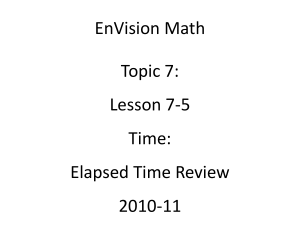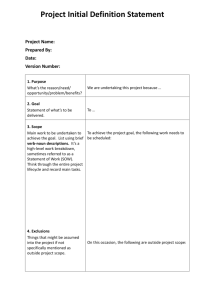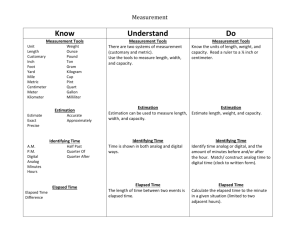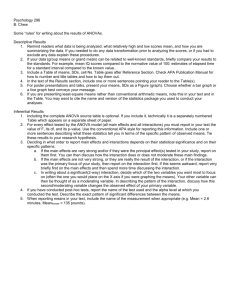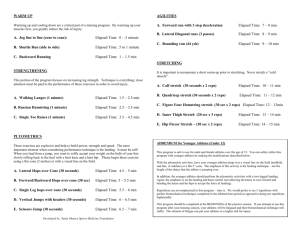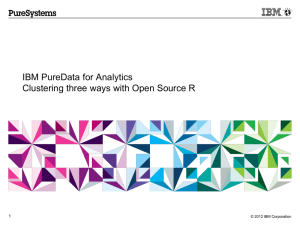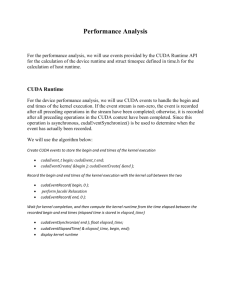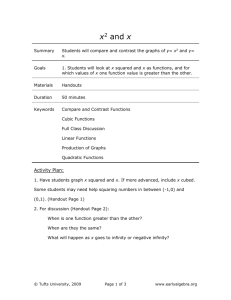Elapsed Time - Tufts University
advertisement
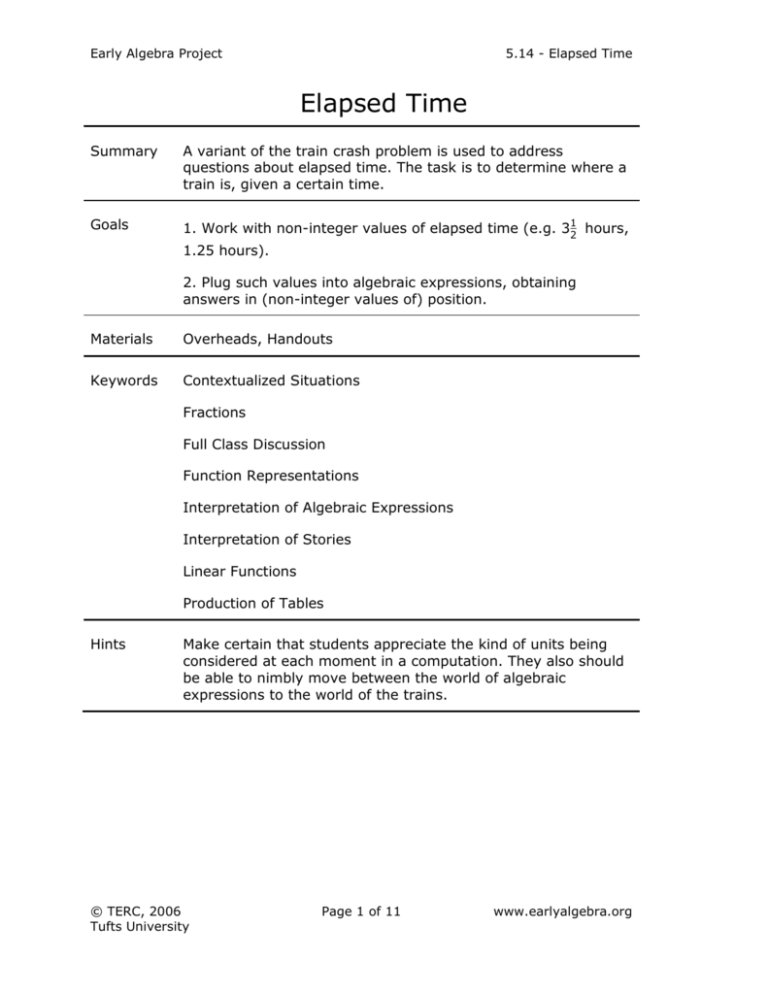
Early Algebra Project 5.14 - Elapsed Time Elapsed Time Summary A variant of the train crash problem is used to address questions about elapsed time. The task is to determine where a train is, given a certain time. Goals 1. Work with non-integer values of elapsed time (e.g. 32 hours, 1 1.25 hours). 2. Plug such values into algebraic expressions, obtaining answers in (non-integer values of) position. Materials Overheads, Handouts Keywords Contextualized Situations Fractions Full Class Discussion Function Representations Interpretation of Algebraic Expressions Interpretation of Stories Linear Functions Production of Tables Hints Make certain that students appreciate the kind of units being considered at each moment in a computation. They also should be able to nimbly move between the world of algebraic expressions to the world of the trains. © TERC, 2006 Tufts University Page 1 of 11 www.earlyalgebra.org Early Algebra Project 5.14 - Elapsed Time Activity Plan: This class has three parts. In Part I, we discuss time intervals: (a) on analog clockfaces; (b) as digital expressions (hours and minutes); (c) as hours and minutes elapsed; (d) and as fractions (mixed or not) of hours. Students work on handouts involving multiple ways to express elapsed time. In Part II, we deal with the multiplication of (fractional values of) elapsed time by speed, giving results in km. The handout they work on has them inserting various time intervals into the formulas for positions of train A (see problem from previous lesson. For homework (Part III), they do problems similar to the ones in Parts I and II. (Train B is used for the homework). Part I: Elapsed Time: Fractional Parts of Hours [40 min; uses Handout pages 2 & 3] 1. Discuss Elapsed Time With the Class [15 min.] During the last lesson, several students were puzzled about fractional (and decimal) expressions of elapsed time. This introduction will address the issues with fractional expressions. However, it cannot fully 'solve' all of the matters that might arise, and we will not consider decimal expressions. Go over several intervals to make sure that students can move among the diverse representational forms. This is the template (see Overhead 1, Page 1) that you may wish to have multiple copies of. Start Time © TERC, 2006 Tufts University End Time Page 2 of 11 Elapsed Time www.earlyalgebra.org Early Algebra Project 5.14 - Elapsed Time The examples below show some items you may wish to discuss using Overhead 1 (Page 1). But in the lesson, elicit times and values from students; don't provide all the values. Elapsed time 4 hours 0 minutes Elapsed time 0 hours 12 minutes © TERC, 2006 Tufts University Page 3 of 11 www.earlyalgebra.org Early Algebra Project 5.14 - Elapsed Time 2. Distribute & then discuss Handout (Pages 2 & 3) [25 min.] Display Handout (Pages 2 & 3) and go over the instructions. Students are to fill in the table using times of their own. When they are done, collect the handouts and discuss various issues that arose: things kids were unsure of, how to get from hours, minutes to fractional values, etc. Part II. Using Elapsed Time in a Formula [40 min; uses Handout Page 5] 1. Recall the formulas for the trains (10 min.) Remind students of the train problem from Lesson 5-13, shown on Overhead 2 (Page 4). Today we're going to focus on the formulas that were used in the example. Train A a(h) = 25 + 50h Train B b(h) = 175 – 70h Here are some questions to consider discussing with students. What units are associated with the 25, h, 50, and a(h) When you know the value of a(h) what does it tell you? How do you figure out where a train is? 2. Explain handout (Page 5), and discuss (calculating position from elapsed time— 25 min.) Go over the new, horizontal diagram of the trains so that the students know that it refers to the same trains as in 5-13. However, this week we assume they do not crash. Before handing out the worksheet/handout (Page 5), use the overhead (Page 5) to go through the first two examples, namely, the cases where the elapsed times are 1 and 1 ½ hours. © TERC, 2006 Tufts University Page 4 of 11 www.earlyalgebra.org Early Algebra Project 5.14 - Elapsed Time The first case is relatively straightforward. The second, as shown, involves breaking up the multiplication by 50 km/hr into two parts (first by one, then by one half). It therefore makes use of the distributive law. Elapsed [hours, minutes] 1h Elapsed [hrs] 1h Position 25 + 50h Position [km] 25 + 50 x (1) Position [km] 25+(50 x 1) 25+(50)= 0 min 1h 30 min 1 1 h 2 1 2 25 + 50 x (1 ) 25+(50 x 1)+(50 x 1 ) 2 Discuss the results kids got in their tables. Make sure they understand what column means. the answer in the last Part III. Homework [10 min; uses Handout Page 6 —Homework] 1. Exactly like Handout Page 5. However, this we are considering the path of Train B. © TERC, 2006 Tufts University Page 5 of 11 www.earlyalgebra.org Early Algebra Project 5.14 - Elapsed Time Overhead 1 Start Time © TERC, 2006 Tufts University (Page 1) End Time Page 6 of 11 Elapsed Time www.earlyalgebra.org Early Algebra Project 5.14 - Elapsed Time Overhead and Handout: Time Elapsed (Page 2) Name: _________________________________ Date: ____________ Start Time End Time Elapsed [hours, minutes] Elapsed [hrs] 1 15 h 60 1h 15 min 11 h 4 10:15 a.m. 11:30 a.m. 11:15 a.m. 11:30 a.m. 5 4 h 1 4 h h h © TERC, 2006 Tufts University Page 7 of 11 www.earlyalgebra.org Early Algebra Project 5.14 - Elapsed Time Overhead and Handout: Time Elapsed (Page 3) Name: _________________________________ Date: ____________ Start Time 10:15 a.m. © TERC, 2006 Tufts University End Time Elapsed [hours, minutes] Elapsed [hrs] 11:30 a.m. Page 8 of 11 www.earlyalgebra.org Early Algebra Project 5.14 - Elapsed Time Overhead 2: Formulas for Obtaining Position from Elapsed Time (Page 4) Formula For Train A: a(h) = 25 + 50h Formula for Train B: b(h) = 175 – 70h © TERC, 2006 Tufts University Page 9 of 11 www.earlyalgebra.org Early Algebra Project 5.14 - Elapsed Time Overhead and Handout: Using Time Elapsed to Find Position of Train (Page 5) Name: _________________________________ Date: ____________ a(h) = 25 + 50h Elapsed Elapstime ed [hrs,min] time [hrs] 0h 0h 1h 1h Position Position [km] Position [km] 25 + 50h 25 + 50 x (1) 25+(50 x 1) 25+(50)= 0 min 1h 30 min 2h 1 1 h 2 2h 2h 30 min 1 25 + 50 x (1 ) 2 25+(50 x 1)+ (50 x 25 + 50 x (2) 2 1 ) 2 1 h 2 3h 25 + 50 x ( ) 3h 30 min 4h © TERC, 2006 Tufts University Page 10 of 11 www.earlyalgebra.org Early Algebra Project 5.14 - Elapsed Time Homework: Position of Train B (Page 6) Name: _________________________________ Date: ____________ b(h) = 175 - 70h Elapsed Elapstime ed [hours, time minutes] [hrs] Position Position [km] 175 -70h 0h 0h 0h 30 min 1 h 2 1 175 - 70 x ( ) 2 1h 175 - 70 x ( 1h 1h 30 min 2h 2h 30 min 3h 1 1 h 2 2h 2 1 h 2 Position [km] 175 - (70 x 175-35= ) 1 175 - 70 x (1 ) 2 175-(70 x 1)-(70 x 175- 70 x (2) 175 + 70 x ( 1 ) 2 1 ) 2 ) 3h © TERC, 2006 Tufts University Page 11 of 11 www.earlyalgebra.org
